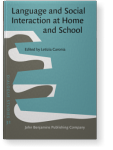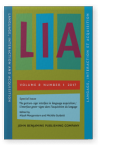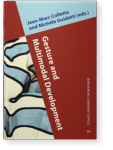Stéphanie Caët
List of John Benjamins publications for which Stéphanie Caët plays a role.
2024 Children’s multimodal participation in interactions and dialogues across different activities in an early childhood education and care setting Interactions and Language Acquisition in Non-Family Settings, Masson, Caroline (ed.), pp. 57–94 | Article
Early childhood education and care (ECEC) settings are challenging contexts for children to engage in conversations. According to previous studies, toddler participation is minimal. However, most studies have focused on vocal productions. This study investigates how gestures also enable children… read more
2021 Chapter 1. Children’s socialization to multi-party interactive practices: Who talks to whom about what in family dinners Language and Social Interaction at Home and School, Caronia, Letizia (ed.), pp. 45–86 | Chapter
Multiparty interactions are crucial situations to study how children can participate in collaborative talk and broaden their experience of various interactional practices. Family dinners are particularly relevant to analyze how children and adults play different participatory roles and how parents… read more
2021 Chapter 2. Filler syllables as precursors of referring expressions The Acquisition of Referring Expressions: A dialogical approach, Salazar-Orvig, Anne, Geneviève de Weck, Rouba Hassan and Annie Rialland (eds.), pp. 41–80 | Chapter
In this chapter, we examine the properties of filler syllables as transition forms in the development of referring expressions. In particular, we hypothesize that fillers are precursors of referring expressions. We focus on the distribution, the phonological form and the referential function of… read more
2021 Chapter 3. Young children’s uses of referring expressions The Acquisition of Referring Expressions: A dialogical approach, Salazar-Orvig, Anne, Geneviève de Weck, Rouba Hassan and Annie Rialland (eds.), pp. 81–113 | Chapter
This chapter investigates the repertoire and the uses of referring expressions in natural dialogues of 28 French-speaking children, aged between 1;7 and 2;6 years old. We focus on three strong forms (nouns, strong demonstrative pronouns and strong personal pronouns) and three weak forms (clitic… read more
2017 A functional approach to self-points and self-reference in a deaf signing child and the (dis)continuity issue in child language The gesture–sign interface in language acquisition / L’interface geste–signe dans l’acquisition du langage, Morgenstern, Aliyah and Michèle Guidetti (eds.), pp. 117–140 | Article
Based on her observation of two deaf children acquiring American Sign Language (ASL) who stopped pointing to persons at around 12 months and then produced reversal errors, Petitto (1987) argued that the discontinuous development of gestures and signs gives support to the hypothesis that language… read more
2015 Chapter 9. First and second person pronouns in two mother-child dyads The Pragmatics of Personal Pronouns, Gardelle, Laure and Sandrine Sorlin (eds.), pp. 173–194 | Article
First and second person pronouns are complex categories for children to acquire. During a transitional period, when they start referring to themselves as subjects, French-speaking children produce a variety of non-conventional forms. The analysis of these uses provide valuable insights on how they… read more
2012 From gesture to sign and from gesture to word: Pointing in deaf and hearing children Gesture and Multimodal Development, Colletta, Jean-Marc and Michèle Guidetti (eds.), pp. 49–78 | Article
In this paper, we explore the issue of (dis)continuity between gestures and signs and gestures and words by comparing three longitudinal follow-ups of a hearing monolingual French speaking child, a deaf signing child (LSF), and a hearing bilingual (French-LSF) child. Our study indicates that the… read more
2010 From gesture to sign and from gesture to word: Pointing in deaf and hearing children Gesture and Multimodal Development, Colletta, Jean-Marc and Michèle Guidetti (eds.), pp. 172–202 | Article
In this paper, we explore the issue of (dis)continuity between gestures and signs and gestures and words by comparing three longitudinal follow-ups of a hearing monolingual French speaking child, a deaf signing child (LSF), and a hearing bilingual (French-LSF) child. Our study indicates that the… read more






